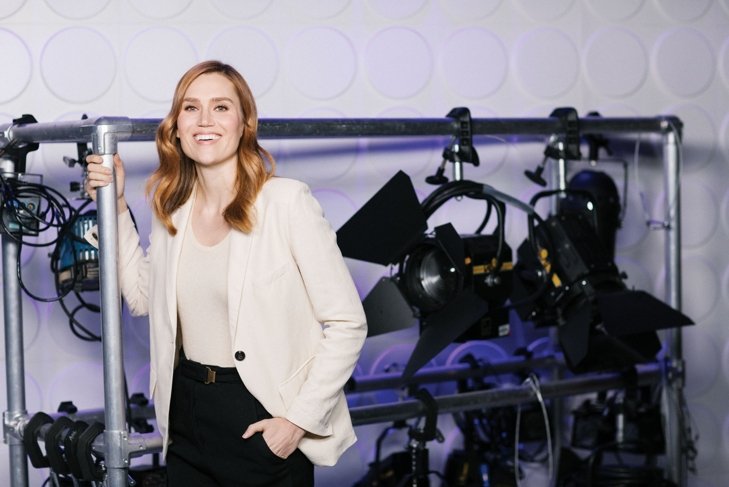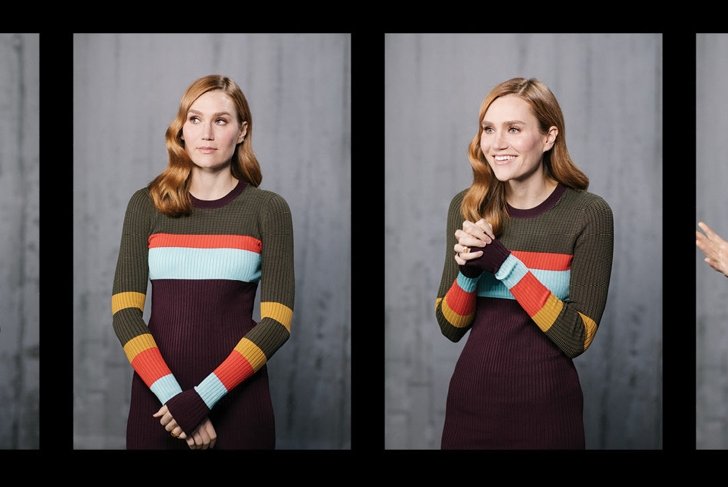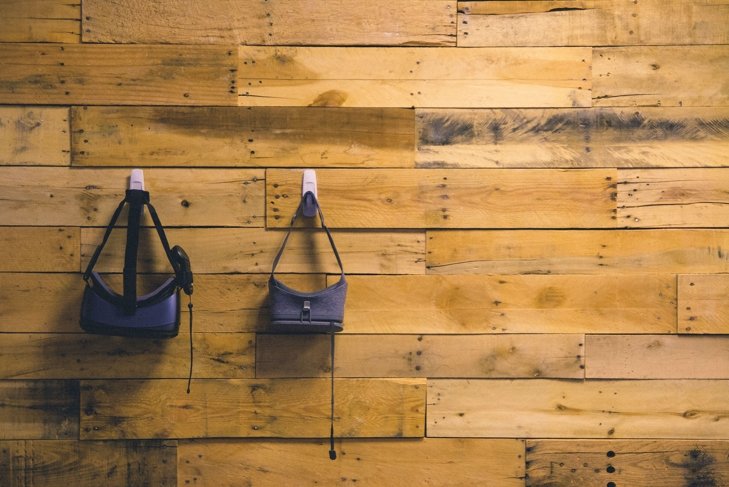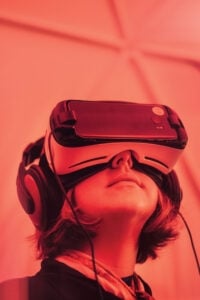
 Photo credit: Yoni Goldberg
Photo credit: Yoni Goldberg
From her home in the beachy, sun-splashed neighborhood of Venice, Los Angeles, Nora Kirkpatrick jumps between two realities. In one, the 32-year-old musician, writer, director and actress juggles a mounting pile of projects including a show she’s executive producing for Sundance Now streaming and a sitcom she recently sold to CBS. The other is taking Kirkpatrick, who’s best known for her Grammy award-winning musical work with indie folk rockers Edward Sharpe and the Magnetic Zeros, to a more virtual plane.
In early 2018, Hulu will release Door No. 1, a virtual reality comedy series where the viewer determines the plot. Written in a choose-your-own-adventure style and filmed from a first-person perspective, Door No. 1 puts viewers in the role of a silent protagonist winding their way through a 10-year high school reunion and making choices that dictate how the night pans out: Will you dance with a former crush or take a chance on someone different? Choose wisely: the fate of the evening hangs in the balance.
“You get access to more of the viewer’s senses in virtual reality than you do in normal storytelling,” says Kirkpatrick, who writes, directs and appears in the series. “You get sight. You get hearing, but you also get this spatial feeling sense. I can make you much more uncomfortable in VR than I can with you watching a story five feet away on TV.”
Where she’s taking us
The ability to place the viewer in thorny situations—to make them feel the awkwardness of sitting between a couple that’s ravenously kissing, for example—is a major reason why Kirkpatrick is drawn to virtual reality. Finding the funniest ways to leverage this “spatial un-comfortability” provides an exciting new challenge for comedy creators in a relatively new medium that hasn’t yet found its defining artists.
“It’s really probably the only time in my career that I’ll be one of the first people to try something,” she says. “I think that’s really exciting because there’s not a lot of rules and we’re kind of figuring them out as we go.”

The other explorers
Kirkpatrick isn’t the only creator mining VR’s comedy capacities. “The Confessional,” a YouTube virtual reality series featuring Trevor Noah, Judd Apatow and Natasha Leggero, debuted this past October. Comedian Reggie Watts released his own VR stand-up special in 2016. Watts and others, like The League’s Paul Scheer, have also strapped on motion-capture sensors and performed more traditional stand-up sets for AltspaceVR’s digital comedy club.
Academic researchers and news organizations have been quicker and better at leveraging VR’s perspective-shifting capabilities and user response. Scientific studies that require participants to either inhabit avatars of a different gender or race, or that use virtual reality to simulate what the world looks like to someone else, show that these digital experiences increase empathy and can effect short-term behavioral changes. The medical community has also jumped on VR’s immersive capabilities. Virtual reality is currently used to help treat a broad array of conditions ranging from phobias and PTSD to chronic pain and lazy eye.
Her prototype
Comedy hasn’t quite figured out the best ways to use VR, but Kirkpatrick believes that the seemingly disparate artistic lives she’s led have put her in a good position to push this particular envelope. Armed with a background in improv theater, years spent touring with Edward Sharpe and an acting résumé that includes stints on shows like The Office and Greek, Kirkpatrick stumbled onto virtual reality in 2014. After watching a VR documentary produced by RYOT film studio, Kirkpatrick became fascinated by the film’s immersive feel and immediately recognized its comedy potential. She partnered with Saturday Night Live alum Mike O’Brien, wrote a few sketches and borrowed some cameras.
The result was Virtually Mike and Nora, a limited-run virtual reality sketch comedy series developed for Hulu’s VR app. Premiering in late 2016, the five-episode series was filmed in first- and third-person perspectives, making the viewer a character in most sketches, and occasionally an all-seeing observer. Kirkpatrick fell in love with the process of visually incorporating the audience, and she noticed that viewers wanted to go even deeper.
“I would see them try to talk back and try to interact with the characters and add their own dialogue,” she says. “I thought it would be really great if what they were saying, what they were doing, really registered.”
Leveling up
Door No. 1 bumps the interactivity up a notch. Throughout the experience, viewers are presented with choices they can make by turning their head toward one character or another. Stare for several seconds and the choice is made, opening up a plot path based on that decision.
Kirkpatrick hopes she and future creators will break even more boundaries and push art a little closer to imitating life itself.
“My goal is to make it keep going until it feels like your life, until it feels like you are making these decisions,” she says. “I think that’s where we’re headed.”
 VR saves the day
VR saves the day
Virtual reality isn’t just for entertainment. These projects are making us kinder, healthier people.
Digital environments that help real ones
Transform into coral and watch underwater ecosystems change as CO2 emissions increase. The Stanford Ocean Acidification Experience—a free VR educational tool—gives users a 360-degree glimpse into how coral reefs will look by the year 2100. Research shows that people who used the VR tool believed acidification to be a greater threat than those who watched the same content on video.
Immersion for equality
Implicit biases—attitudes and prejudices we’re not conscious of—are nearly impossible to break. By placing users in avatars of another race, researchers in California, Spain and beyond are observing how VR can be used to change our gut reactions. These racial bias studies have led to short-term behavioral changes thus far, but pioneers in the field believe that better understanding of VR can lead to longer-lasting results.
This is your grandma’s VR
Rendever, a startup based in Boston, creates VR experiences for the elderly. Aiming to reduce depression and loneliness by giving users with limited mobility new experiences to talk about, Rendever’s system comes loaded with more than 100 prefab “trips,” ranging from digital beach vacations to tours of historical landmarks, and it connects to Google Street View, allowing users to virtually visit real places from their own pasts.

How VR works
Unlike traditional films or television, which are limited by the size of the screen, virtual reality provides a 360-degree view of a filmed or computer-generated environment, giving the illusion of actually being there.
Viewers typically slip on a VR headset that’s equipped with either two tiny, built-in screens—one for each eye—or two lenses that receive visual input from a cellphone inserted in the headset. Instead of seeing a single image, the way we do on movie screens, virtual reality shows the right eye one image and the left eye a slightly offset version of the same image, allowing users to see the scene in front of them in 3D. Motion sensors built into the cellphone or the headset itself track where the user is looking and move the scene accordingly, allowing viewers to look around the new world and feel proximity to objects or characters around them.
Keeping cool while blazing trails
Breaking new ground means facing problems that haven’t been encountered before. Here’s how Kirkpatrick keeps her body healthy and her head clear.
1. Work, reset, repeat
Kirkpatrick breaks up her work day with hiking, biking or circuit training in the afternoon. The recess is healthy and productive. “I have a lot of good ideas when I’m exercising,” she says.
2. Stay centered
Though they’re sometimes tough to fit in her schedule, yoga and meditation help Kirkpatrick clear her mind and stay calm. “I’m trying to focus more and more on really taking the time to do that,” she says.
3. Explore other passions
When stuck on a problem, Kirkpatrick breaks out the musical instruments—no surprise given her impressive accordion playing with Edward Sharpe and the Magnetic Zeros. Playing music “really puts your brain in a different head space,” she says, which can spark new ways of thinking about current issues.



